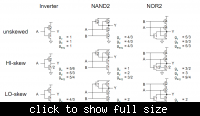iVenky
Advanced Member level 2
- Joined
- Jul 11, 2011
- Messages
- 584
- Helped
- 37
- Reputation
- 76
- Reaction score
- 35
- Trophy points
- 1,318
- Location
- College Station, Texas
- Activity points
- 6,124
Recently I read about logical effort but I quite couldn't understand that.
Ivan Sutherland says
"The logical effort of an inverter is taken to be one.The logical effort for any other logic function describes how much worse it is than an inverter at producing output current,given an equivalent amount of input capacitance".
Why does the effort of producing the same current varies with the logic function?
Also please explain me this definition.
Thanks in advance.
Ivan Sutherland says
"The logical effort of an inverter is taken to be one.The logical effort for any other logic function describes how much worse it is than an inverter at producing output current,given an equivalent amount of input capacitance".
Why does the effort of producing the same current varies with the logic function?
Also please explain me this definition.
Thanks in advance.
Last edited:

